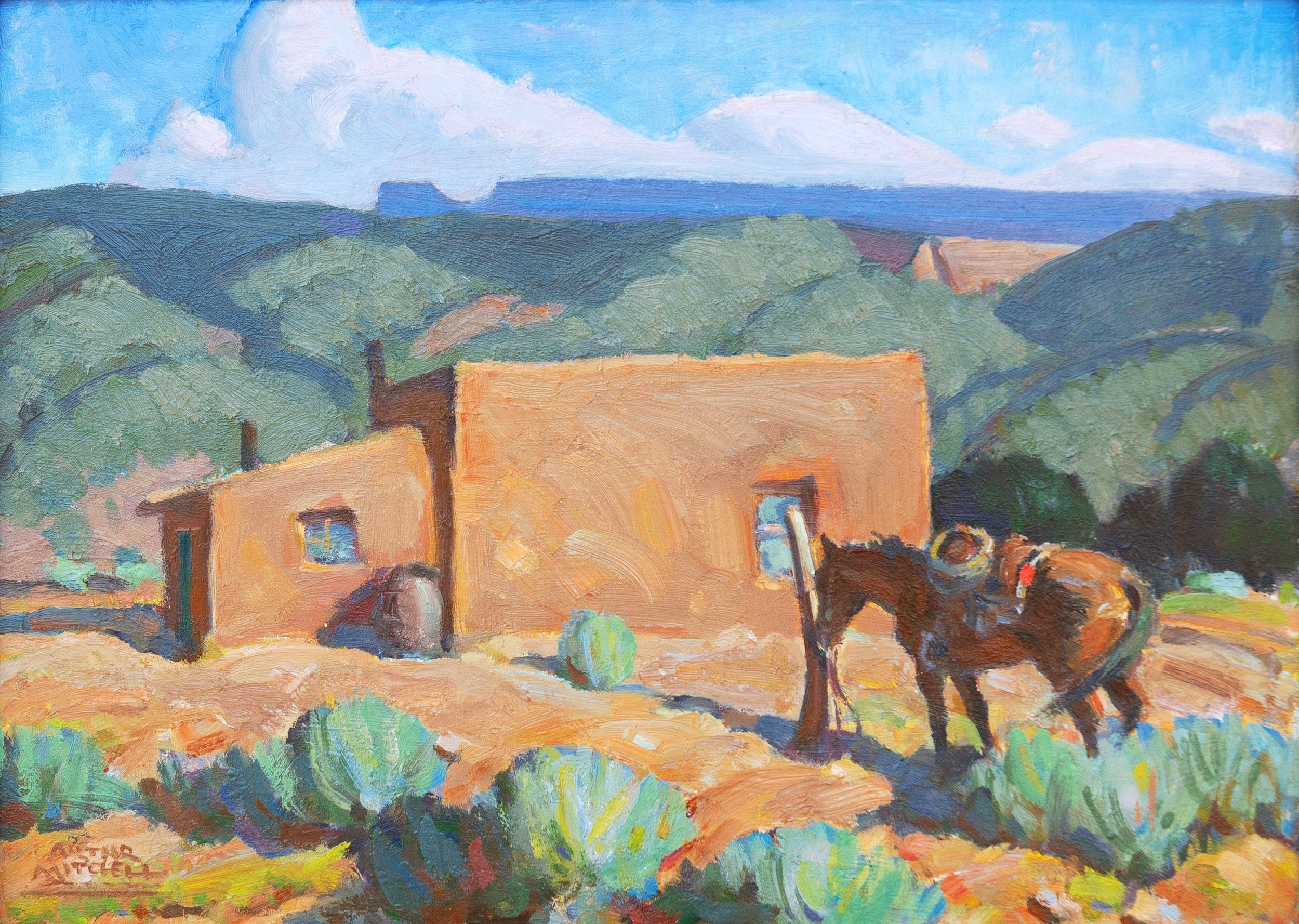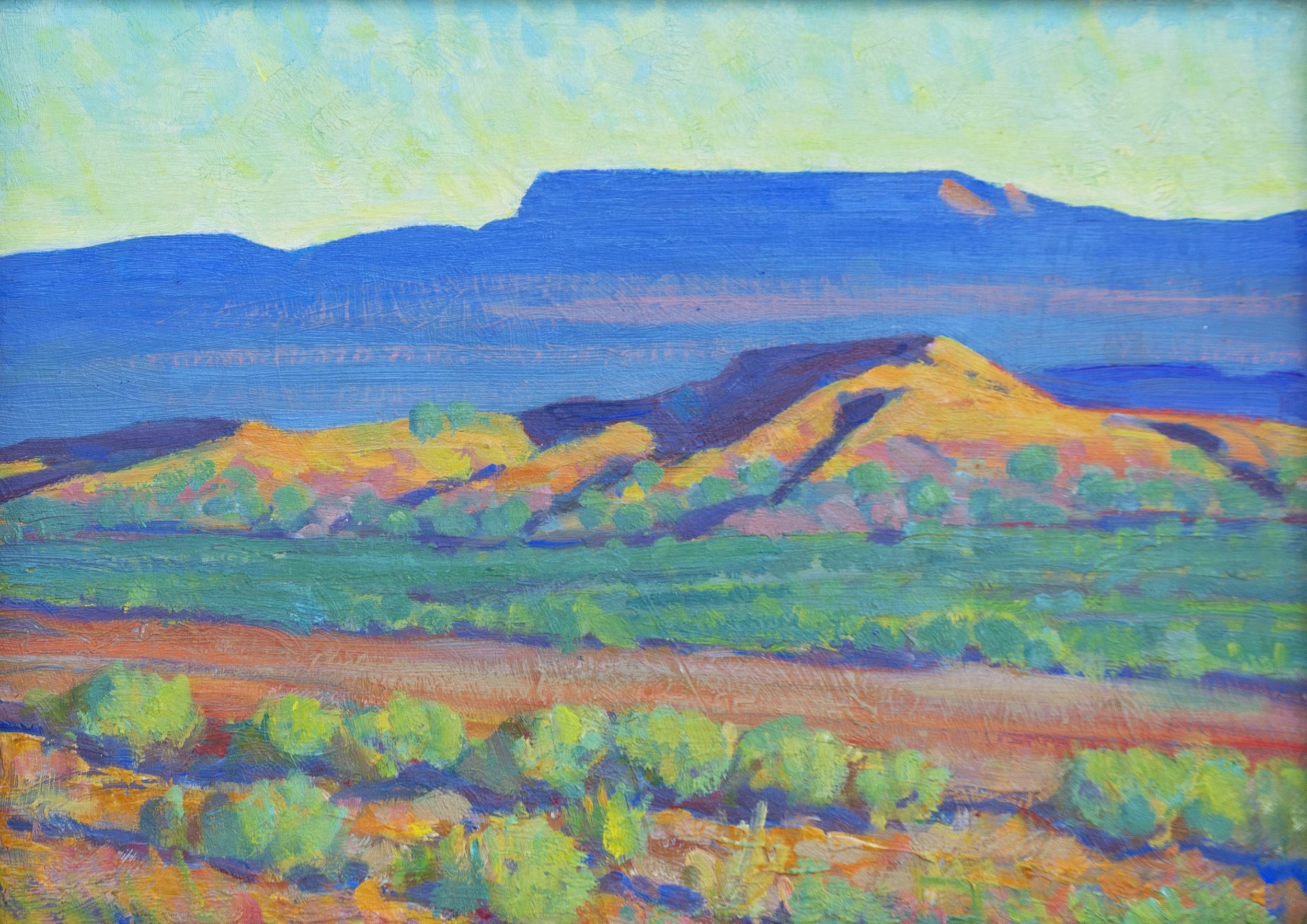
Hispanic Folk & Religious Art Collection
—The Devotion of the Penitente Brotherhood
Brothers of Light
The A.R. Mitchell Museum's collection of Hispanic Colonial Art comprises numerous religious objects, some dating back to the 18th century. These objects were utilized in homes and moradas, the meeting places of the Penitente Brotherhood in southern Colorado. The Penitente Brotherhood, also known as the 'Brothers of Light' or 'La Sociedad de Nuestro Padre Jesus Nazareno,' was a clandestine organization dedicated to acts of penance and charity.
They supported one another and assisted members of their communities, particularly during times of illness or death. This folk art was created by untrained individuals as acts of piety. The creators, usually residing in remote areas, relied on their memories of statues and paintings they had seen in distant churches. They used readily available materials such as cottonwood roots or pine slabs, as well as gesso made from native gypsum and organic colors.
A BRIEF HISTORY OF THE PENITENTE BROTHERHOOD
1540.
Spanish conquistadors entered the Rio Grande Valley area of New Mexico accompanied by Franciscan Friars (who practiced extreme penitence, including self-flagellation). The Spanish brutally conquered the Pueblo people— Native Americans in the American Southwest who share common agricultural, material, and religious practices that includes the Acoma, Zuni, Tewa, and Hopi peoples— forcing them to convert to Christianity and enslaving them under the encomienda system.
1598.
Under the leadership of Popé, a Tewa religious leader, the Pueblo people organized and revolted against the Spanish priests, soldiers, and government officials who had enslaved and brutalized them during the time of the encomiendas. Approximately 400 Spanish and 600 Pueblo people were killed during the revolt. This was the first successful rebellion against the Spanish, who did not return to the area for over a decade.
Juan de Oñate led Spanish soldiers, priests, and colonists into the Rio Grande Valley area of New Mexico, establishing colonies throughout the area and subjugating the Puebloans.
1693.
Many of the colonists who had intermarried and formed a sort of interdependence with the Puebloans remained. However, there were no officials to enforce laws or priests to conduct religious functions in these remote areas. As a result, the most respected men in each village assumed these responsibilities. This marked the beginning of Los Hermanos de la Fraternidad Piadosa de Nuestro Padre Jesus Nazareno, more commonly known as the Penitente Brotherhood.
The soldiers returned, under the leadership of the govenor Diego de Vargas, and lay siege to city of Santa Fe. They promise the Pueblos clemency in exchange for allegiance to the Spanish Crown and the Spanish faith— and so the Pueblos surrendered and Vargas assumed governance of the retaken colony. As the Franciscan priests did not return, the brotherhood continued to do charitable work and perform religious ceremonies.
1680.
In Mexico City, Augustín de Iturbide’s Provisional Governing Board declares the Mexican Empire’s independence from Spain, culminating decades of decentralized, local uprisings against the Crown. Ramón Gutiérrez del Mazo, the first political leader of Mexico City, distributes pamphlets with the declaration for all peoples, courts, and soldiers to read— it is distributed nationwide, but the nation remains unstable. Tensions brew with the neighboring United States.
1821.
1848.
After years of armed conflict from the Southwest to the Yucatán, a peace is brokered between the United States of America and the Second Federal Republic of Mexico. The Treaty of Guadalupe Hidalgo is signed, ceding more than half of Mexico’s territory to the ambitious Americans— Including New Mexico and Colorado, the lands of the Penitentes.
1850.
Jean Baptiste Lamy, a French-American Catholic, is appointed by Pope Pius IX as the first Bishop of the Diocese of Santa Fe. He arrives in New Mexico faces resistance to his writ and— along with his successor, Jean Baptiste Salpointe— unsuccessfully, and brutally, attempts to suppress the Brotherhood as part of the “Americanization” of the church. The Brotherhood seeks refuge underground, hidden in Penitente Canyon as well as plain sight.
1947.
In a new era of tolerance, Santa Fe Archbishop Edwin Byrne publishes a statement recognizing the Penitente Brotherhood as legitimate Catholics, declaring, “"if the Brethren proceed with moderation and privately and under our supervision, meanwhile giving a good example to all us Catholics and citizens, they have our blessing and protection." While the persecution of their sect subsided, centuries of subterfuge are not so easily shaken. The Brotherhood continues to operate in secrecy.
The Museum’s collection of Penitente artifacts vary in form and medium— The paintings on flat boards are known as “retablos,'“ while the molded or sculpted figures are referred to as “bultos.'“ Collectively, they are loosely referred to as “santos,'“ representing anything holy, be it a person or an object. The various saints are typically identified by their attributes, such as the objects they wear or carry. For instance, San Jose wears a crown and carries a flowering staff, San Felipe holds a rosary and a spray of lilies, San Rafael carries a fish, San Antonio and Santa Rita bear skulls, and San Ramon holds a monstrance. These attributes are connected to stories from their lives or martyrdom.
The Virgin Mary is depicted in various ways, but when portrayed as Nuestra Señora de Guadalupe, the patron saint of Mexico, she is often shown standing on a quarter moon with the sun's rays behind her.
The black figure represents death and is commonly referred to as “La Muerte'"or “Doña Sebastiani.'“ She served as a reminder that death was always near and inevitable. The Penitente’s were notorious for their macabre re-enactments of the crucifixion of Christ, in which they would emerge from behind closed doors, don their crosses and whips, and undertake a most painful march through the desert. During these processions, “La Muerte” was often pulled in a cart, brandishing a bow, arrow, spear, or ax.
Relics of an Underground Faith
Curation
The original exhibit at the museum was prepared by Curator Juanito “John” Jimenez, with assistance from Carol Patrick.
Jimenez, who grew up in Trinidad, has been living in Santa Fe since 1967. He is a professional artist and santero who teaches courses in retablo painting. Jimenez is highly regarded for his expertise in Spanish Colonial Art in Santa Fe. His artwork has been widely exhibited and is featured in the permanent collections of prestigious institutions such as the New Mexico International Folk Art Museum, Albuquerque Museum of Fine Arts, Millicent Rogers Museum, the Santuario de Chimayo Church, and numerous notable collections in New Mexico and Colorado. His works are also held in private collections across the United States, Europe, South America, Mexico, Canada, and Australia.
Carol Patrick, also a local of Trinidad, is a retired educator and administrator from Trinidad State Junior College. She holds a Bachelor of Arts degree from Colorado College and a Master's Degree from the University of Northern Colorado. Her senior thesis was titled "The Sacred Images of the Penitente Brotherhood."










